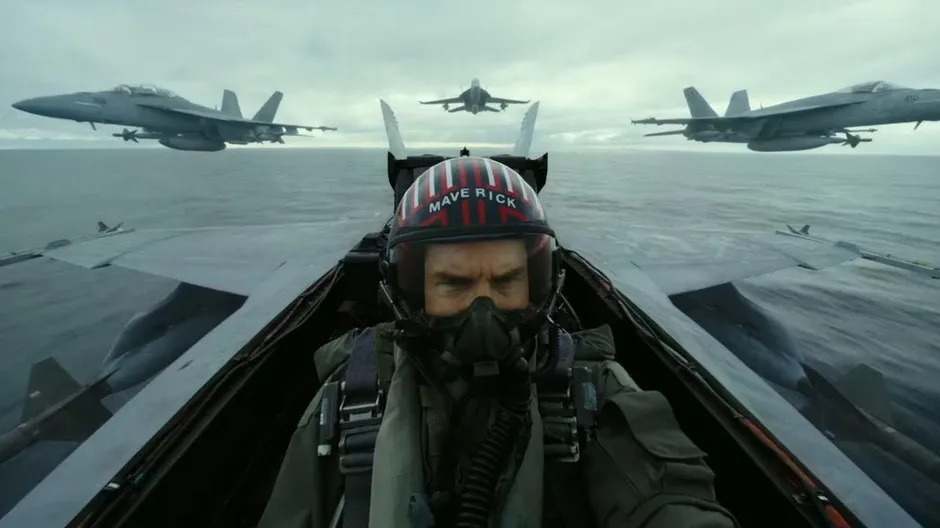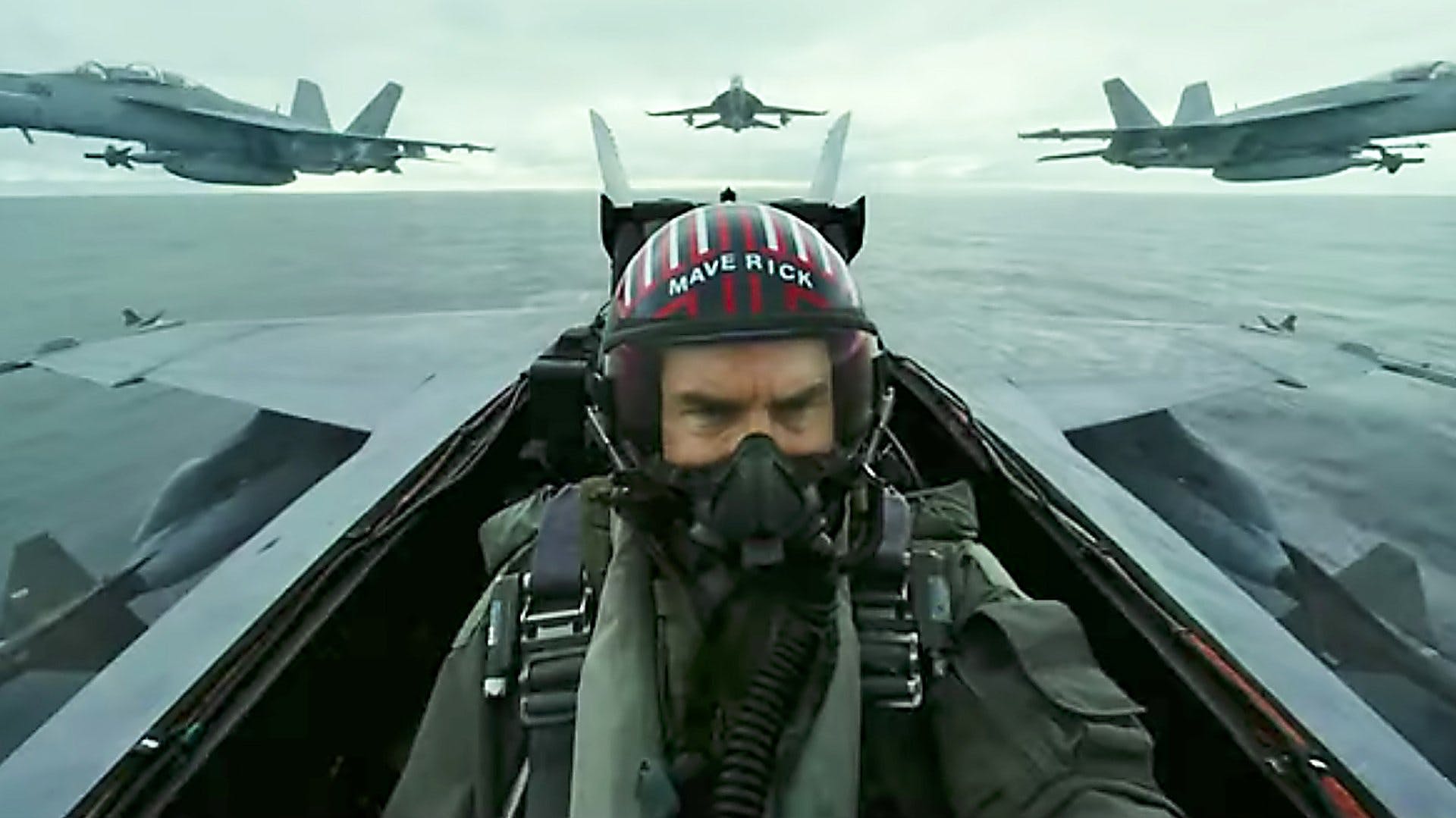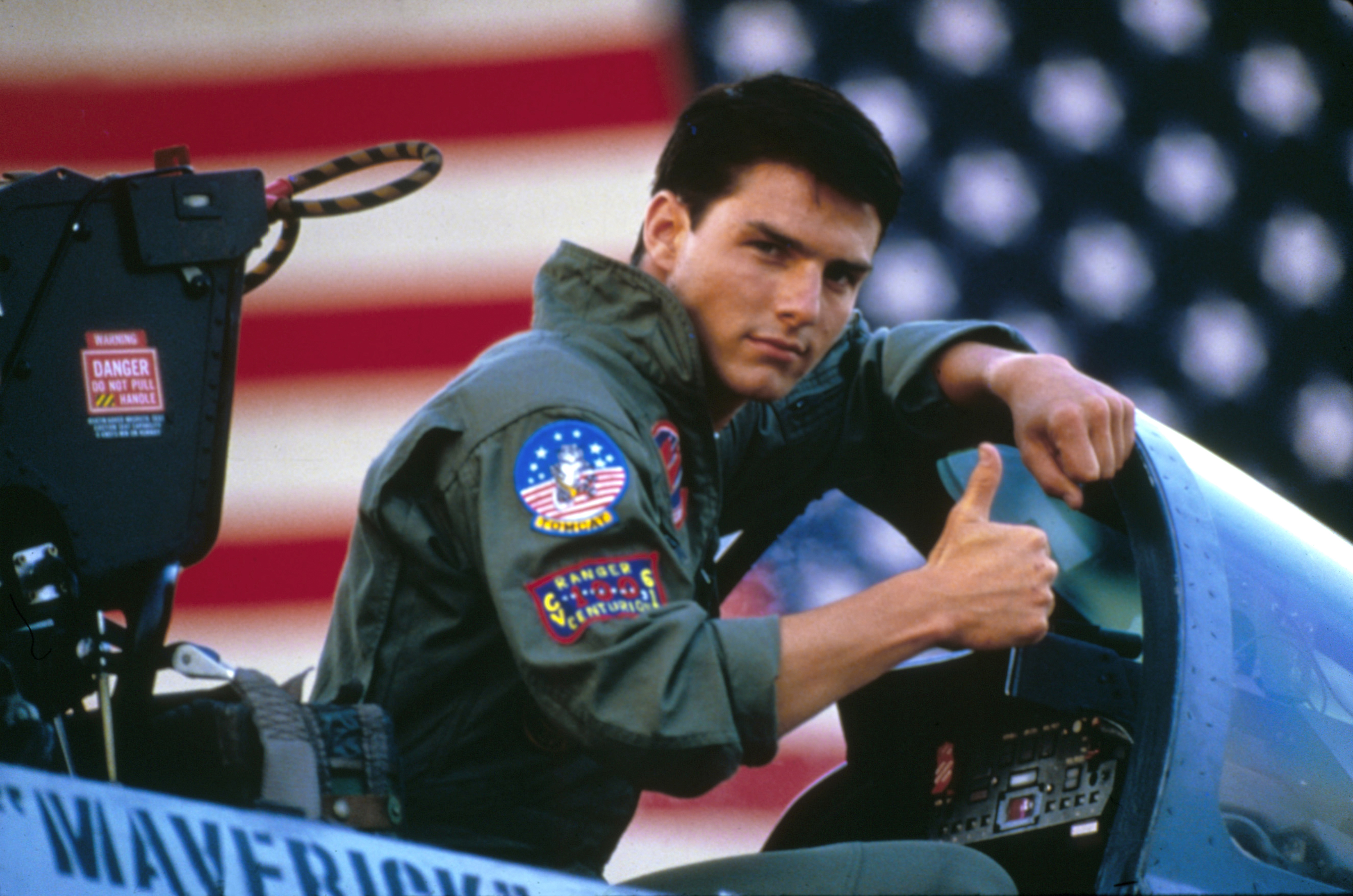“Can’t repeat the past?’ he cried incredulously. ‘Why of course you can!’”-The Great Gatsby
“That’s what I sleep with every night: the future of this fucking industry!”-Tom Cruise
In James Salter’s novel The Hunters, a fighter pilot on rotation in the Korean War considers the end of his career: “He was thirty-one, not too old, certainly; but it would not be long.” Salter, who flew F-86 Sabres in Korea and shot down a MiG north of the Yalu River on the Fourth of July, 1952, continues: “His eyes weren’t good enough any more. With an athlete, the legs failed first. With a fighter pilot, it was the eyes. The hand was still steady and judgment good long after a man lost the ability to pick out aircraft at extreme ranges. Other things could help to make up for it, and other eyes could help him look, but in the end it was too much of a handicap. He had reached the point, too, where a sense of lost time weighed on him.”
Top Gun: Maverick, which has its world premiere in Cannes next week before opening theatrically on Memorial Day weekend, was shot over the course of a year, from spring 2018 to 2019, during the course of which its star, Tom Cruise, turned 57. A sense of lost time weighs on Cruise’s character, Navy aviator Capt. Pete “Maverick” Mitchell, as well, but he gets a shot at redemption when his superior officers decide that Maverick — who, again, is 57 years old — is the only pilot for a near-suicidal mission flying state-of-the-art multimillion-dollar jets behind enemy lines with the fate of the free world in the balance.
But, I mean, hey: Maverick is still two decades younger than his Commander-in-Chief. And the Botox has Tom Cruise and Joe Biden both looking good.
The original Top Gun, the highest-grossing film of 1986, was about beautiful boys dick-fencing in the sky before setting homoerotic rivalries aside to take on the Russkies. Shot in a high-gloss advertorial style by Tony Scott (the critic Pauline Kael called him “Tony ‘Make It Glow’ Scott”), toplined by the grinning yuppie cocksman Cruise and produced with the full, enthusiastic cooperation of the United States Navy, it was the most successful military recruitment ad of all time, a triumphant showcase for American soft and hard power at a time when our sundowning president was proclaiming the reversal of American decline. (The soft-focus nostalgia of Reagan’s “Morning Again in America” went hand-in-hand with his rhetorical war against the counterculture and flat-track bully military incursions into Grenada and Libya.) Three and a half decades on, Top Gun: Maverick is the perfect blockbuster for America under gerontocracy. Our ancient ruling class is clinging to power like a dementia patient clutching its nurses’ sleeve, and the old Hollywood studios, like Top Gun’s Paramount, are teetering, with theatrical attendance yet to return to pre-pandemic numbers amid competition from streaming and apps. “Time is your greatest enemy,” an old friend says to Maverick in the new film, which rolls back the years with an even more hysterical fantasy of American push-button world-policing and cinematic spectacle.
Maverick’s callbacks to the original Top Gun echo across the uncanny valley. The new film is an eerie simulacrum of the old, with new characters filling old slots on the story chart and endlessly self-referential dialogue that ties the present to the past, despite all the new technologies for warfare and special effects (it’s hard to tell where the former ends and latter begins). The Pentagon’s advanced fighter programs are a legendary money pit, but physics-defying storytelling and the occasional moment of CGI and digital compositing, a noticeably new augmentation to the old cockpit-mounted 35mm cameras, hazy filters and MTV-style cutting, give Maverick a sense of weightlessness, a futurism that feels Facetuned rather than Space-Aged.
We open with Maverick as a test pilot pushing the limits of new experimental aircraft, like Chuck Yeager in The Right Stuff — a cowboy who flies by intuition, in contrast to the anonymous, bureaucratic remote control of drone warfare. (“The future is coming,” he’s told, “you’re not in it.”) But a new mission requires his particular set of skills, and he returns to the United States Navy Fighter Weapons School to train up a new crop of attractive young camera fodder. (His disapproving commander is played by Jon Hamm, once again cast, as per his blood-borne peevish gravitas, as an asshole Fed.) Among the cocky flyboys is Lt. Bradley Bradshaw, callsign “Rooster,” the son of his best friend and Radar Intercept Officer Goose, who died in the 1986 film; Miles Teller, as Rooster, dresses just like Anthony Edwards, who played his dad.
The mission is to blow up a secret uranium enrichment facility maintained by a “rogue state” that is “unsanctioned by NATO.” Aviation nerds (bless them) will note that the new Top Gun pilots fly the F-18 Super Hornet rather than F-14s — “relics,” the F-14s are called, but given that Tom Cruise is back in the cockpit after all these years that almost constitutes a spoiler — and that the bad guys, who still wear black helmets and tinted face shields, fly CG recreations of the fifth-gen Russian Su-57, just as the faceless enemies flew Soviet aircraft in Top Gun ’86. “The enemy” is unnamed, as it was in 1986, when it was obviously Russians or their Cold War proxies.
Top Gun wasn’t the only Reagan-era martial epic that, like the Hollywood President, weaponized the action blockbuster to avenge the emasculation of Vietnam, nor is it the only one to be remade with its geopolitics cautiously updated: the 2012 remake of 1984’s Red Dawn changed the invading power from Russia to China, then changed China to North Korea in postproduction to avoid offending a big foreign market. The vagueness of Top Gun: Maverick makes it a bit like a video game, as do the mission parameters — fly in low, through a narrow valley, deliver a precision strike on a tiny target and peel out to safety, dodging antiaircraft missiles and enemy aircraft — which points up the link between gaming, modern warfare’s reliance on joystick-jockey drone operators and military recruitment. (Maverick’s orders also sound like the plan to blow up the Death Star.) Yet at the same time, the resonances of the 1980s combined with this strike against an Evil Empire (Reagan loved Star Wars) make Top Gun: Maverick a dream come true, in ways the filmmakers could not necessarily have anticipated, for audiences preoccupied by America’s renewed hostilities with Russia.
At one point a character lists of Maverick’s tours of duty, including the Balkans and Iraq, “both times” — a roll call of America’s end-of-history mission drift. It’s also a reminder that wherever there’s trouble in the world, Tom Cruise is there, like Mission: Impossible’s Ethan Hunt. (Cruise’s M:I amanuensis Christopher McQuarrie took a pass at the Maverick screenplay.) Cruise’s ’80s love interests always felt tacked-on — in the first Top Gun, his sex scene with Kelly McGillis, the scene with the alien probe–looking tongue kiss, was literally tacked on, added after test screenings — and despite a tentative romance here with Jennifer Connolly, his Maverick is more like Ethan Hunt, a lapsed volcel holding back the dark, who loves deeply but is cautious about committing, lest he leave behind a family devastated by grief after he dies defusing a dirty bomb or something. Like many latter-day Cruise characters, Maverick is an everyman superman: he wears weekend-dad clothes, has manly hobbies (here, fixing a vintage P-51 Mustang actually owned by Cruise) and is constantly remind by every supporting character of his superior abilities, moral rectitude and vital importance to national defense. “The Navy needs Maverick,” chokes a dying man with one of his precious remaining breaths.
Cruise’s messianic self-belief extends into a commitment to cinema itself: Top Gun: Maverick will open exclusively in theaters with at rumored 120-day window before streaming — a source of much contention with Paramount, who are trying to pivot to their streaming service Paramount+ — and the film, though shot digitally, follows the Mission: Impossible by relying heavily on belief-defying practical stunts. Much of the aerial action in Top Gun: Maverick was filmed with IMAX-resolution cameras secreted within the cockpits of fighter jets, where the actors also sat, mostly in the backseat. (Your armed forces denied Tom Cruise permission to actually pilot an F-18.) This pays off in big-screen spectacle, mounted by director Joseph Kosinski with a sense of clarity and grandeur; as the planes shoot through the valleys surrounding northern Nevada’s Naval Air Station Fallon, the windshield becomes a proscenium framing the wild blue yonder. Jets bank and invert in midair, as they did in 1927’s Wings, the first-ever Best Picture winner, and the overall impression is of the American commercial cinema ardently fighting for its future by supercharging its past.
There are legacy sequels, and then there’s Top Gun: Maverick. Every moment in the film is less like biting into one of Proust’s madeleines than like crushing it up and snorting it, beginning with the opening title card for the late Don Simpson, the prodigiously wired producer of the original. Any Xennial who was ever babysat by Top Gun will feel it all rushing back with the font of the opening credits, that soaring Harold Faltermeyer synth-rock score segueing into “Danger Zone” as the crew of an aircraft carrier launch jets in long-lens photography cutting through a smoggy yellow heat shimmer of jet exhaust. The bubble enclosing past and present is airtight. Jennifer Connolly’s character is an Easter-egg reference to a stray line of dialogue from 1986, and Val Kilmer, who played Maverick’s rival pilot in Top Gun, returns here in a role that acknowledges his diminished health; Kilmer, another ’80s golden boy who became known for his personal and professional eccentricities, is a reminder of how mortality can afflict those who stray from the true path of permanent moviestardom followed by Immortan Cruise.
Top Gun: Maverick recycles all the old scenes: Mav rides a motorcycle alongside a runway as a plane takes flight; cocky hotshot fighter pilots strip down to play sports on the beach and listen exclusively to Golden Oldies. In the midst of a barroom dispute, the preening alpha played by Glen Powell (born October 1988) saunters over to the jukebox and punches in the code for Foghat’s “Slow Ride.”
With Top Gun: Maverick you can feel the focus-grouped storytelling and updated demographics of the modern IP blockbuster — not so much because there’s a female pilot, played by the terrific Monica Barbaro, but because there are so many endings, with so many characters getting their turn to resolve their trauma. (Top Gun: Maverick is fairly ruthless with its ensemble — poor Manny Jacinto must have had a whole arc cut — but is still, by its nature, fan service.) The sequel’s glossy sentimentality isn’t cynical, like the flashy hard-sell sentimentality of the original was — it’s smarmy, and a reminder that the American military, which during the Reagan years teamed up with Hollywood animals like Don Simpson, spent the Obama administration working closely with Marvel.
Top Gun primarily concerned its pilots’ hypercompetitive brotherhood; here, dynamics hinge more on father-son bonds, via Maverick’s strained relationship with Goose’s kid. It’s possible to read this new film, with its cascading third-act impossibilities and reciprocal acts of self-sacrifice and reincarnation, as a Boomer’s apologia and fantasy of reconciliation with the next generation. America, insists Top Gun: Maverick, is already great.
This article appeared in an InsideHook newsletter. Sign up for free to get more on travel, wellness, style, drinking, and culture.























